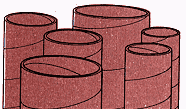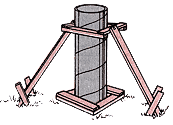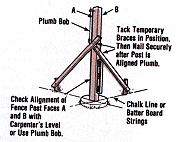Positioning the Form
1. The diameter of the QUIK-TUBE™ form should be at least double the post or pillar diameter it will support. When supporting deck posts or other load-bearing members the form should extend down below the frost line.
2. Use a posthole digger or shovel to dig a hole to the proper depth. Do not make the hole wider than needed to minimize backfilling.
3. Place 6" of QUIKRETE™ All-Purpose Gravel on the base of the hole to help with drainage.
 4. Cut the QUIK-TUBE™ rigid form to size. In most cases you will want to size the form so that the finished footing will extend out of the ground approximately 2" to 6". This protects lumber from direct contact with the ground and allows rainwater to drain rapidly from the area. 4. Cut the QUIK-TUBE™ rigid form to size. In most cases you will want to size the form so that the finished footing will extend out of the ground approximately 2" to 6". This protects lumber from direct contact with the ground and allows rainwater to drain rapidly from the area.
5. Center the form in the hole. Check that the top of the form is level using a mason's level.
6. Carefully backfill against the sides of the QUIK-TUBE™ form to support the tube and keep it from shifting during the pour.
 7. When forms are placed aboveground in applications that will be backfilled later, make sure the bottom of the QUIK-TUBE™ is properly braced. Build a bottom collar out of scrap lumber, and keep the form plumb by adding braces above its midpoint as needed. Nail and stake all braces firmly in place. 7. When forms are placed aboveground in applications that will be backfilled later, make sure the bottom of the QUIK-TUBE™ is properly braced. Build a bottom collar out of scrap lumber, and keep the form plumb by adding braces above its midpoint as needed. Nail and stake all braces firmly in place.
Positioning the Post
| When the post or pillar is to be embedded in the concrete, position it inside the QUIK-TUBE™ prior to beginning the pour. Use pressure-treated lumber or apply creosote equivalent to prevent below-the-ground rot. Coat metal posts with rut inhibitor. Center the post or pillar inside the form. Brace it as needed to prevent shifting during the pour and while the concrete sets. Use a mason's level to make certain the post is plumb and its top is level. |


|
Estimating the Concrete Needs
For a cylindrical form, such as QUIK-TUBE™, multiply the square of the form's radius (one-half its diameter) by 3.1416. This gives you the area of the QUIK-TUBE™ form. Multiply this area by the form height to determine the volume of concrete needed. The table given below simplifies the calculation process for QUIK-TUBE™ jobs. It lists the bags of mix needed per linear foot of QUIK-TUBE™ form for the various tube diameters. For example, if you are using 50-pound bags of QUIKRETEŽ Fast-Setting Concrete, to pour the 8" diameter, 4' long form that calculation would be:
1 bag per linear foot x 4' = 4 bags
If 80-pound bags of QUIKRETEŽ Concrete Mix were used, the calculation would be:
3/5 bag per linear foot x 4' = 2 2/5 bags
| Bags of Concrete Needed Per Foot of Form Height |
| QUIK-TUBE Diameter |
6" |
8" |
10" |
12" |
Quikrete Fast Setting
Concrete 50-lb bags |
1/2 |
1 |
1-2/5 |
2 |
Quikrete Concrete Mix
80-lb bags |
1/3 |
3/5 |
1 |
1-1/3 |
Quikrete Concrete Mix
60-lb bags |
1/2 |
4/5 |
1-1/4 |
1-1/3 |
Quikrete Fiber-Reinforced
Concrete Mix 60-lb bags |
1-1/2 |
4/5 |
1-1/4 |
1-3/4 |
Placing the Concrete
QUIKRETEŽ Fast-Setting Concrete is the ideal concrete mix for this job. It gains its initial set in 20-40 minutes and reaches strength of 1000 psi in 1 day so construction work can continue almost uninterrupted. QUIKRETEŽ Concrete Mix is another excellent mix for constructing QUIK-TUBE™ footers.
1. Apply concrete release agent if the smoothest possible concrete surface is desired.
2. Mix and place the concrete in the form. Work it down and around any post or pillar set in the form, but do not use a mechanical vibrator to settle the concrete.
3. Carefully embed any anchor plates or bolts needed in the top of the form. Make absolutely certain these anchors are centered and level before the concrete gains its initial set.
4. If forms are to be removed, do so within 24 hours. Cut the QUIK-TUBE™ with a sharp knife or power saw set to the correct cutting depth. Simple peel the form away from the concrete.
For Best Results
- Store QUIK-TUBE™ forms at least 4" off the ground. Cover them to keep dry.
- Never place concrete into a wet QUIK-TUBE™ form. Never use a mechanical vibrator to compact concrete inside a QUIK-TUBE™ form.
- Never reuse a QUIK-TUBE™ form.
|
